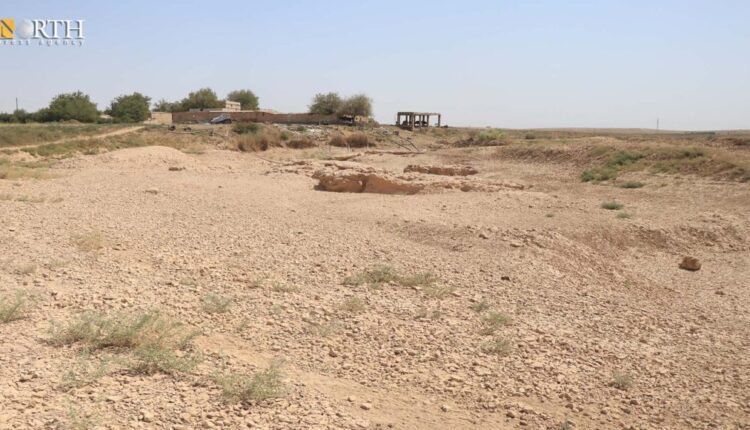Under the scorching heat of summer, Ali Amin, 30, seems heartbroken by the fruit trees in his farm on the Khabour bank in the countryside of Hasakah Governorate in northeastern Syria, after they have been decimated by thirst and the formerly green leaves have turned dry and brown.
Areas around the Khabour basin in the Syrian Jazira (northeast) were well-known as one of the most fertile agrarian lands, however, the drought in the last two years and the reduction of water by Turkey for about two years turned fertile areas into arid ones and vegetation no longer exists.
Climate change, which affects the region profoundly, threatens agriculture, the main pillar of economy in the region which is the main source of income for families.
In the outskirts of the village of Shamoka in the west of Hasakah, Amin Ali holds a bunch of dried leaves of his trees and disperses them onto the ground. Tens of his trees have been reduced to ashes by the drought.
The young farmer, who wore a green hat and white-black scarf, said, “Water no longer suffices our lands because of the Khabour drought and rarity of rainfall.”
Standing in front of a dried apple tree, Amin added that “These trees used to be our way of living. 100 trees have been dried due to the drought.”
As many others, Amin depends on irrigating his crops with wells, but they have dried as the underground reservoir ran out due to the rarity of rainfall.
Annually, farmers used to harvest rich crops of apricot, apple, peach, pear, grapes, among many others, before production was decimated recently.
Amin expressed his fears over the continuation of the drought, which would put an end to the remainder of his trees, “We would change our profession and migrate if this continues.”
Desertification
Observers are concerned that the continuation of climate change could lead to ecological and food catastrophes in northeast Syria amid signs of drought in a lot of wells in the region due to the immense consumption of underground reservoir water.
Tarrad Sheikh Ibrahim, an ecological engineer from Hasakah, said that the Khabour drought is “catastrophic.”
The water of the river was producing more vegetation. It used to provide wells with water, which in turn was used in irrigating seasonal crops, both in winter and summer.
The Khabour drought is affecting ecology by reducing vegetation and humidity in the air, which leads to more dust and gases, according to Tarrad.
Observers attribute the current ecological dire reality in northeast Syria to the rarity of rainfall due to climate change caused by over-cutting of trees to be sold as wood in the last years, and to the increase in exhausts of cars, factories and generators in cities, all of which have a share in increasing the carbon dioxide and hypoxia in the air.
Ibrahim warned of an ecological catastrophe in the region in the future, “In case of no rainfall, the region would face the worst, and desertification would invade northward, contrary to the rule which used to invade from north to south.”
The ecological engineer summed up these dangers: “our fate depends on rainfall and on the awareness of people in using the underground water.”
Tragic status
Drought and desertification have recently increased immensely. The symptoms of such a crisis are appearing on the horizon, especially in the Syrian Jazira, which used to be the food basket of the whole country. Its crops are decreasing, which decimates even the livestock, which comes second.
Under a tent in the outskirts of the city of Hasakah, Ayatullah Numan, 50, who comes from the governorate of Hama, arrived days ago from the city of Raqqa after he was exhausted by mortgaging system which he depends on in feeding his sheep. An acre is being sold in return for 100,000 SYP.
Numan, who stands close to his herd which is starved by hunger, said, “We are in a tragic position, livestock is perishing. We have been suffering from drought for two years.”
“Price of lands in the mortgaging system is rocketing due to recession in agrarian spots.”
“Last year, some herders had 600 sheep. Today they have just 150. One of my relatives had 2,000 sheep, which is reduced now to only 100,” he told North Press.
“In case the drought continues, the situation is going to be awful,” Numan said in an indication of the dangers facing livestock in the region.

